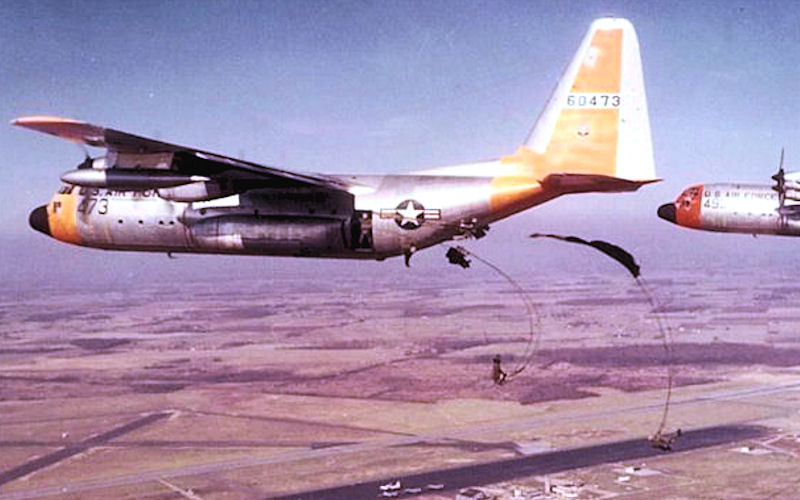

The C-130 Hercules is easily one of the longest-serving series of military aircraft in the world, having first made its appearance in the mid-1950s.
Though the Herc, as it’s popularly known, doesn’t really look anything like the high-performance ultra-nimble fighters and trainers modern aerobatic teams use today, you might be surprised to hear that the U.S. Air Force once upon a time had a C-130 demonstration team of its own!
Built as a replacement for the Air Force’s WWII-era C-47 Skytrains, C-46 Commandos, and the slightly newer C-119 Flying Boxcar, the C-130 was designed to transport troops, jeeps, and machinery in and out of combat zones, landing on unimproved fields and dirt strips should runways be inaccessible.
WATCH: 360-degree skydiver view jumping into the Army-Navy game
The first of the Hercs to enter service with the USAF were known as the C-130A.
By early 1957, a number of C-130As were sent to Campbell Army Air Field in Kentucky where they would be taking platoons of soldiers from the 101st Airborne Division up for a series of coordinated airdrops.
The weather had something else to say about these plans, however, and they were cancelled when high winds rendered the drop zone too dangerous for the exercise.
Instead of wasting a prime opportunity to log flight hours on their brand new Hercs, the four aircraft commanders assigned to each plane — Captains Jim Aiken, Gene Chaney, Bill Hatfield, and David Moore — decided to fire up the planes and go for a flight.
All four pilots came from the 774th Troop Carrier Squadron, aka “The Green Weasels.”
After spending some time practicing flying in close proximity, the four decided to drop down low above Campbell in tight formation, roaring over the base to the glee of soldiers below. After a few passes, the Hercs landed, only to be given another chance at perfecting their formation routine again just a few days later, thanks to poor weather.
Upon returning to the former home of the 774th — Ardmore AFB, OK — the four pilots quickly worked together to develop an idea inspired by their antics at Campbell.
Like the Air Force’s Thunderbirds and the Navy’s Blue Angels, they too could form a demonstration team to show off the incredible capabilities of the C-130 and the airmanship of some of the service’s finest pilots.
Over the course of 1957, Aiken, Chaney, Hatfield and Moore, practiced their show routine when time permitted, flying with precision at extremely small distances of separation between the aircraft.
In 1958, the four got wind of a ceremony requiring a flyover at Ardmore, and with their wing commander’s approval, broke away from a parade of 36 Hercs, flying in a diamond pattern low over the airfield, and culminating in a bomb-burst breakaway.

Their act was met with horror and indignation from many Air Force officers on hand to witness the ceremony, but a considerable number of brass — many with political power within the branch — were impressed enough to allow the four pilots to perform as a team from there on out.
First known as the Thunderweasels, a play on the Thunderbirds demo team and their own Green Weasels unit, these four pilots were moved to Stewart AFB, TN, where they began practicing a 20-minute show routine to be later performed at shows across the country.
The team proved to be a big hit and a huge publicity bonus for Lockheed.
By the end of 1959, the team had adopted a new name, The Four Horsemen, alluding to their four-ship flight, though some say it was a reference to the University of Notre Dame’s 1924 Rose Bowl champion football squad.
The Horsemen went on to fly a dozen official shows that year, and a number of unofficial flyovers and demonstrations in-between.

The team’s existence was slowly but surely threatened throughout 1959.
Lockheed had already developed the C-130B, a more fuel-efficient long range improvement on the A model, and the Air Force needed as many operational Hercs to be made available as they could muster.
What the B model made up for with range and efficiency, it lost with its handling, making it a dangerous proposition for close-formation flights.
In the spring of 1960, three years after they flew their first impromptu show over Fort Campbell, the Four Horsemen were disbanded, never to fly another demonstration.
Aiken, Chaney and Hatfield remained with the Air Force while Moore moved on, entering the civilian world not long after the team was broken up.
It’s highly unlikely that anything like the Four Horsemen will ever exist ever again, and today, the only C-130 demo still flying is the Blue Angel’s Fat Albert, a Marine Corps-crewed blue, white, and gold Herc that flies a solo routine at airshows across North America.
